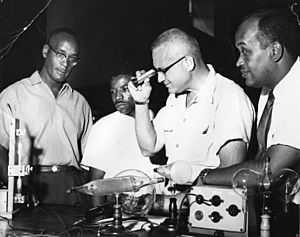Herman Branson facts for kids
Quick facts for kids
Herman Russell Branson
|
|
|---|---|

Branson, right, at Morgan State University circa 1960
|
|
| Born |
Herman Russell Branson
August 14, 1914 Pocahontas, Virginia, U.S.
|
| Died | June 7, 1995 (aged 80) |
| Citizenship | American |
| Alma mater | |
| Scientific career | |
| Fields | Physics, Biochemistry |
| Institutions |
|
| Thesis | I. The effects of soft x-rays on Tubifex Tubifex, II. The construction and operation of an x-ray intensity measuring device, III. The quantization of mass. (1939) |
| Doctoral advisor | Boris Padolsky |
| Doctoral students | Titus Pankey Arthur Thorpe |
Herman Russell Branson (born August 14, 1914 – died June 7, 1995) was an American scientist. He was a talented physicist and chemist. He is most famous for his important work on the structure of proteins, especially the alpha helix. He also served as the president of two different colleges. He received a special grant from the Rosenwald Foundation to support his studies.
Contents
Early Life and Education
Herman Russell Branson earned his first degree, a Bachelor of Science (B.S.), in 1936. He studied at Virginia State College. Later, in 1939, he received his Ph.D. in physics from the University of Cincinnati. His main advisor there was Boris Podolsky.
Branson's PhD Research
His PhD research was split into three main parts. First, he studied how X-rays affected tiny worms called Tubifex tubifex. These are also known as sludge worms. Second, he designed and built a device to measure the strength of X-rays. Finally, his third research area explored new ideas about how mass works, using a complex physics idea called the Dirac Equation.
Career at Howard University
After working briefly at Dillard University, Branson joined Howard University in 1941. He started as an assistant professor teaching physics and chemistry. He stayed at Howard for 27 years. During this time, he made big contributions to understanding how proteins work. He also studied how proteins are involved in diseases like sickle cell anemia.
He held many important roles at Howard University. He became the head of the physics department. He also directed a special program for science and math students. He worked on projects for the Office of Naval Research and the Atomic Energy Commission. One of his students was Marie Maynard Daly. She was the first African American woman in the United States to earn a doctorate degree in chemistry.
Discovering Protein Structures
In 1948, Branson took a break from Howard University. He went to the California Institute of Technology. There, he worked in the lab of a famous chemist named Linus Pauling. Pauling asked Branson to help figure out the structure of proteins.
The Alpha and Gamma Helices
Branson used his strong math skills to find possible spiral shapes, called helices. These shapes needed to match information from X-ray tests. They also had to fit certain chemical rules set by Pauling. After several months, Branson found two main helical structures. One was a tighter spiral, which Pauling called the "alpha" helix. The other was a looser spiral, named the "gamma" helix.
After this work, Branson went back to Howard University. A few months later, he received a letter from Pauling. It included a draft of a scientific paper about the two helices. Branson was listed as the third author. Pauling and his assistant, Robert Corey, were the first two authors. Pauling asked Branson for his thoughts on the paper. Branson replied that it looked good and approved it for publication. He also asked for copies of the paper once it was printed.

